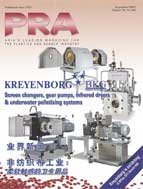 |
 |
In this Edition September 2011 |
LEAD FEATURE |
COMPANY NEWS |
MATERIALS NEWS |
MACHINERY NEWS |
ENVIRONMENT NEWS |
INJECTION MOULDING ASIA |
RUBBER JOURNAL ASIA |
PRA September 2011 Electronic Issue Now Available |
Environment News
PET bottles light up homes and make walls in Manila
N
on-biodegradable plastic, which is becoming infamous now in an eco-aware society, is redeeming itself as the king material for practical yet sustainable technology: the solar light bulb and the plastic bottle wall.The MyShelter Foundation, a Philippine-based non-government organisation spearheaded by social entrepreneur Illac Diaz, and proponent of the A Litre of Light project has introduced to the country the solar light bulb using discarded PET bottles, usually a 1-litre soda PET bottle to contain the filtered water diluted with bleach (to act as anti-algae agent). The bottle is inserted vertically onto a piece of galvanised iron, (a commonly used material for roofing in the country) so that the half top part is exposed to the sun and the half bottom part juts indoors. The bulb only functions at daytime.
This practical technology, although developed by students from US-based Massachusetts Institute of Technology where the organisation had gotten the idea from, was actually invented back in 2002 by Alfredo Moser, a Brazilian engineer who found a nifty way to light up his workshop during the energy crisis in his hometown. In his version, he used a 2-litre PET bottle with its cap covered with an empty camera film canister.
The solar bulb, an alternative to the day lighting method, harnesses natural solar light giving off an approximately 50-60 watt lighting in a 360-degree arc.
The 1-litre version gives off an approximately 55-watt lighting. According to Diaz ,"PET bottles are more ideal for this purpose (unlike a plastic sheet, for example, which refracts light in a columnar beam) because they refract light in 180 degrees, enough to light up a 40-sq m room." A solar bulb is good for five years and serves to dilute the high cost of electricity in the country.
As PET bottles light up homes, they can also help make bright minds. The foundation has erected the first of eight class rooms using PET bottles for walls. The project has piloted in a 560-sq m land in Laguna Province, South of Manila. Said Diaz, not only are the PET bottles durable, but are also three times stronger than the conventional concrete material; not to mention that plastics degrade only after about 600 years!
The bottles are filled with liquefied adobe (a combination of clay, sand, water and organic materials) and stacked like regular bricks and reinforced with discarded materials including glass bottles, chicken feathers and human hair as well as using environment-friendly pozzolanic cement, making the structure sturdy and earthquake-proof. According to Diaz, the structure is also inexpensive. A wall panel costs about US$46.
While this bottle school is touted to be the first in Asia, a town in Guatemala also started building its own bottle school in 2009. With the help of volunteers from the US-based Hug It Forward organisation, the townsfolk of Granados were mobilised to gather about 6,000 PET bottles for the bottle school. The bottles are filled with plastic grocery bags, chip bags and other common waste materials. To align the bottles, they are encased within metal fencing and gaps are filled with trash materials. Three layers of cement were applied on both sides of the bottle panels for finishing. The NGO has built 12 bottle schools since then.


